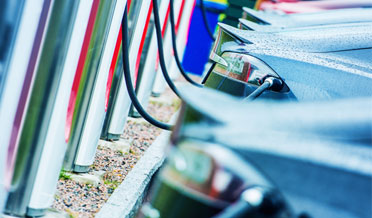Electric Vehicles Charging Options
Electric Vehicles Charging Options to Keep in Mind
Purchasing an electric vehicle (EV) is certainly not an impulse buy. After driving vehicles with gasoline-powered internal combustion engines, switching to an EV comes with a lot of research and a lot of preparation. Although TV commercials depict charging to be equivalent to filling a gas tank, that is not the case. As a savvy, informed consumer, you are doing your homework to know and understand your Electric Vehicles Charging Options and we are here to help.
Know Your Limits and Your Electric Vehicles Charging Options
Few people know how far their car can travel on a full tank of gasoline; once the gauge shows ¼ of a tank, it is time to fill it again, with dozens of options within a mile radius of most urban settings. EV owners must be much more cognizant of the range achieved on a full battery charge and aware of every charging option along familiar routes.
Most EVs can travel between 200 and 300 highway miles on a full battery charge. That figure is rather fluid and the range is improving with each generation of EVs. Most people can handle that range since few people are required to drive that far every day and if you are driving more than 200 miles/day, you are less likely to consider an EV.
Know Your Electric Vehicles Charging Options
Currently, there are three charging options for electric vehicles. Undoubtedly EV owners will use all three options.
- A Level One charger uses an ordinary 110-volt outlet and offers the greatest flexibility of charging locations. Each EV is sold with a Level One charger at no additional cost. While a Level One charger offers tremendous freedom it is also a very slow charge; a depleted battery to a full charge might take as long as 24 hours. A Level One charger is excellent for charging in remote locations with plenty of time to recharge. It is also a very good backup plan should other options fail.
- A Level Three charger is a public, for-pay charging station. This charging option is very fast in comparison—from 3 to 20 miles of range per minute. Even at the lowest setting, that is a complete charge in less than 1 ½ hours; you could probably get a full charge while shopping. The cost to charge will vary, depending on the cost of a Kilowatt/hour of electricity. Entrepreneurs are rushing to fill the present and future needs for Level Three charging stations.
- A Level Two charger operates within the middle ground between the first two options. It will be the focus of our investigation. Level Two chargers use a 220-volt outlet—like those used for an electric dryer—and will charge a depleted battery bank in about 4 hours. They are an affordable, at-home charging option, so let’s explore this value option.
Before making a purchase, make sure to select a charger that is compatible with your EV. Currently, there are two types of Level Two chargers available: a plug-in portable charger and a permanent, wall-mounted charger.
- A portable charger will need a 220-volt outlet but will require the security of an enclosed garage. This may require an electrician to install the proper outlet in your garage.
- A wall-mounted charger will require an electrician for installation.
- An electrician will also assess whether your current electrical service panel has adequate power to handle the Level Two charger along with the normal household electrical current load.
- A good quality Level Two charging station can cost between $300 and $1,200, depending upon several optional features. An additional fee will be required for professional installation for wall-mounted.
- Newer Level Two chargers can produce at least 30 amps of power, adding both speed of charge and miles of operation to the charge. The extra capacity will help build capacity for future charging needs.
- Like many cutting-edge purchases, some charging stations may have Wi-Fi features that allow you to schedule the charge (when the rate drops) and monitor the progress.
Want to Learn More About Your Electric Vehicles Charging Options?
Our four decades of experience as a Houston Electrician and contractor AirPro Houston provides you with the skill and expertise for maximizing your Electric Vehicles Charging Option.
We have financing options available with great options with up to 72-month terms with approved credit. Call us today at 281-880-8805 and let us partner with you for all of your electrical repair and installation needs.
